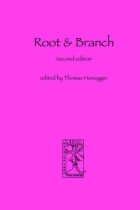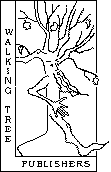Review of Root and Branch

 (to the main page on Root and Branch)
(to the main page on Root and Branch)
The following review of Root and Branch was published in Variations (literature magazine of the university of Zürich) No. 4 (2000), pp. 177-180. Peter Lang Publishers.
Please note that this review refers to the first edition of Root and Branch, which is now out of print. The content of the current edition varies with respect to this.
Understanding Tolkien
When professor J.R.R. Tolkien (1892-1973) set himself the task to create "a mythology for England", as he put it, he used his extensive knowledge of European myths, legends and folk tales as a basis for his work. To give his stories a feel of authenticity and as an intellectual game to please himself, Tolkien used elements from familiar tales in the building of his fictitious world, Middle-earth. He took, for instance, the name Gandalf (and others) from the Edda, the sinking of Atlantis appears as Númenor in The Silmarillion and it is no coincidence that in The Hobbit Bilbo stole a cup from the dragon Smaug.
Among Tolkien scholars and fans alike hunting for these links is a favorite pastime. Tolkien did not appreciate this digging for roots. He used the analogy that one should eat the soup and not wonder from which ox the bone in the broth came from. It is not that Tolkien objected to analysis (as a professor he himself earned his money analysing stories), but he feared that it would distract from the only thing that mattered: the story.
The most prominent among the rootdiggers' is professor Tom Shippey. His The Road to Middle-earth (London: George Allen & Unwin, 1982. A second, revised edition was published in 1992) is still unrivalled in its perceptiveness of Tolkien's modus operandi.
It is therefore entirely justified that in the first article of Root and Branch, a collection of four papers on Tolkien, homage is paid to professor Shippey, for he discussed the way Tolkien incorporated the folk tale of The Man in the Moon in his stories before. The article "The Man in the Moon: Structural Depth in Tolkien" is divided into two parts. In the first half the author gives an extensive and detailled overview of all the occurences of the Man in the Moon; from the medieval thief of a thornbush (with perhaps Biblical references) to the English nursery rhyme of the 19th century. In the second half Thomas Honegger analyses the way Tolkien elaborated on the original Middle English poem. He focusses on the two poems (and their different versions) Tolkien wrote about the 'man in the moon who came down too soon'. It is a pity that the appearance in Tolkien's Roverandom is only mentioned in passing. Like most roo-diggers, the author could not resist having a guess at why Tolkien used this particular piece of folklore; "a construction of a missing linking tradition between medieval and modern Man in the Moon poems". Perhaps.
It is interesting to see how Tolkien developed the theme within his own work. Because Thomas Honegger quotes in full most of the relevant sources, this article is also of interest to those not familiar with the books by Tolkien.
It is odd that The Lord of the Rings -Tolkien's best known book- combines massive, world-wide popularity with general critical disdain. Patrick Curry addressed this enigma in his book Defending Middle-earth: Tolkien, Myth and Modernity (Edinburgh: Floris Books, 1997). In his paper in Root and Branch he covers more or less the same territory, focussing more than in the book on the critics. In "Tolkien and His Critics: A Critique" he tackles the individual reviewers head on, refuting all the criticisms they brought against The Lord of the Rings. Escapist, misogynist, racist and fascist tendencies - it has all been refuted before. What the author adds to this is a bleak view of reviewers who are incapable of doing justice to Tolkien because they either do not understand what he was doing (or in some cases could not be bothered to actually read the book!), or they objected the fact that Tolkien did not comply to the values of what Curry calls 'modernity': "the co-dependent power of corporate and finance capital, the modern political state and modern science" (p. 121f). Curry shows convincingly that a number of critics were blinded by their feminist, marxist or other biases, but to group all these dogmas together under the term 'modernity' with such a wide definition is unreasonable . Yet I gladly forgive Mr Curry, because his defence -if one is needed- is erudite and his polemic piece is a pleasure to read.
Things - just like The Lord of the Rings as a work of art - are not as black and white as Curry implies. He himself mentions that the feminist and therefore 'modernist' author Ursula le Guin has been perfectly capable of making an excellent, unbiased analysis of Tolkien's work. Another feminist author who has been equally unbiased is Margaret Atwood. In the third paper Christina Ljungberg Stuecklin quotes extensively from Atwood's unfinished PhD-thesis, in which Atwood focusses on the metaphysical opposition between supernatural good and supernatural evil. She distinguishes in The Lord of the Rings three Nature-goddesses: Goldberry, Galadriel and Elbereth Gilthoniel. Stuecklin herself discusses those themes that are found both in Tolkien's fantastic and Atwood's realistic fiction.
The final paper in Root and Branch is a bit of a curiousity. It discusses examples of problems a translator may encounter if The Lord of the Rings were ever translated into Sanskrit. All these problems stem from the cultural difference between Christians and Hindi. For instance, the term 'Black Rider' conveys to Europeans something foreboding, evil, but for an Indian reader the opposite is true. The author concludes that for a Hindu the book will always deal about foreigners, and that "the normally hidden racistic strand within Tolkien's world at once becomes painfully visible. The Lord of the Rings becomes a book with a plain colonialist view that is trying to reestablish the 'superioriy' of the Europeans over all other races of the world." (p. 177) This is ridiculous. It is not the translator's job to change the cultural identity of a work, and a Hindu reader can be expected to realise that the author has been working from a different cultural background. It is hard to imagine, and has not been proven by the author, that a careful translation of The Lord of the Rings into Hindi will become racist and neo-colonialist, for if a translation alters a book in such a way, then it is a poor translation. This paper is an example of oversensitive Western political correctness - another candidate for Patrick Curry's definition of 'modernity'. Yet the discussion of how a culture radically different from ours views Tolkien's work is interesting, and helps towards explaining why -with few exceptions (Turkish and Indonesian)- there have been made no translations of Tolkien's books outside the Western world. [ed: please note that this paper was used only in the first edition, which is no longer in print. It is not included in the second edition of Root and Branch]
Root and Branch - Approaches towards Understanding Tolkien is an interesting, thought-provoking publication by Walking Tree Publishers. It is also makes valuable reading for those whose interests reach beyond Tolkien.
Thomas Honegger (editor), Root and Branch - Approaches Towards Understanding Tolkien. Walking Tree Publishers. Zurich and Berne, 1999. 182 pages. Paperback. ISBN 3-9521424-1-7.
René van Rossenberg
[ed: Please note that this review refers to the first edition of Root and Branch, which is now out of print. The content of the current edition varies with respect to this.]

Read reviews of other Walking Tree Publishers books

